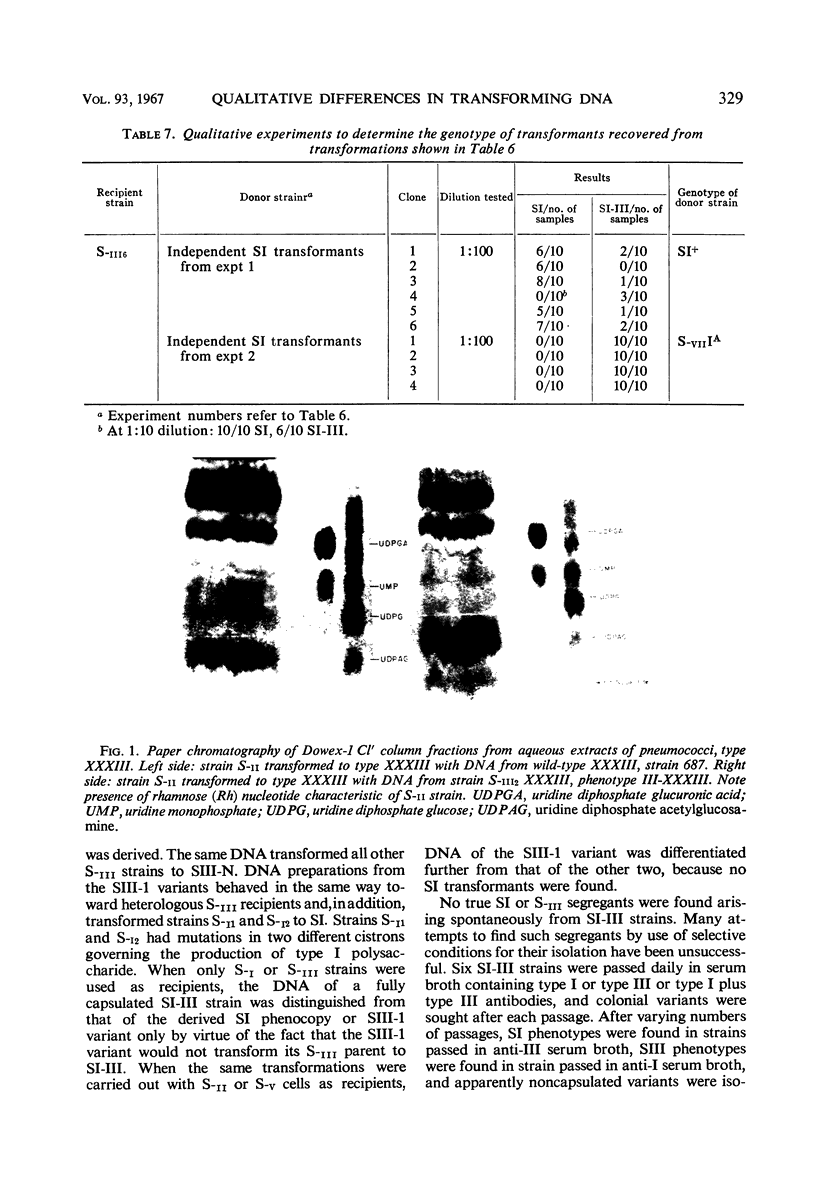Abstract
A method is described for estimating quantitatively the frequency of transformation of pneumococci to new capsular types. It is found that, when S-III cells are exposed to deoxyribonucleic acid (DNA) from wild-type I strains, transformation to SI occurs at a frequency 20 to 60 times that of transformation to the binary type SI-III. SI markers on DNA isolated from binary strains behave qualitatively and quantitatively in a different manner from the same markers on DNA from wild-type I strains and will transform S-III cells only to SI-III. Strains are described which produce only one capsular polysaccharide, but which are genetically binary and carry a second capsular genome with a mutated gene so that the second polysaccharide is not produced. Stability and other characteristics of binary strains are discussed, and one hypothesis for the genetic organization of binary strains is presented.
Full text
PDF













Images in this article
Selected References
These references are in PubMed. This may not be the complete list of references from this article.
- AUSTRIAN R., BERNHEIMER H. P., SMITH E. E., MILLS G. T. Simultaneous production of two capsular polysaccharides by pneumococcus. II. The genetic and biochemical bases of binary capsulation. J Exp Med. 1959 Oct 1;110:585–602. doi: 10.1084/jem.110.4.585. [DOI] [PMC free article] [PubMed] [Google Scholar]
- AUSTRIAN R., BERNHEIMER H. P. Simultaneous production of two capsular polysaccharides by pneumococcus. I. Properties of a pneumococcus manifesting binary capsulation. J Exp Med. 1959 Oct 1;110:571–584. doi: 10.1084/jem.110.4.571. [DOI] [PMC free article] [PubMed] [Google Scholar]
- FOX M. S., HOTCHKISS R. D. Initiation of bacterial transformation. Nature. 1957 Jun 29;179(4574):1322–1325. doi: 10.1038/1791322a0. [DOI] [PubMed] [Google Scholar]
- Hotchkiss R. D. CYCLICAL BEHAVIOR IN PNEUMOCOCCAL GROWTH AND TRANSFORMABILITY OCCASIONED BY ENVIRONMENTAL CHANGES. Proc Natl Acad Sci U S A. 1954 Feb;40(2):49–55. doi: 10.1073/pnas.40.2.49. [DOI] [PMC free article] [PubMed] [Google Scholar]
- LACKS S., HOTCHKISS R. D. A study of the genetic material determining an enzyme in Pneumococcus. Biochim Biophys Acta. 1960 Apr 22;39:508–518. doi: 10.1016/0006-3002(60)90205-5. [DOI] [PubMed] [Google Scholar]
- SMITH E. E., GALLOWAY B., MILLS G. T. The isolation of uridine pyrophosphorhamnose from two noncapsulated variants of pneumococcus type II. Biochim Biophys Acta. 1959 May;33(1):276–277. doi: 10.1016/0006-3002(59)90536-0. [DOI] [PubMed] [Google Scholar]
- SMITH E. E., MILLS G. T., BERNHEIMER H. P., AUSTRIAN R. The presence of an uronic acid epimerase in a strain of pneumococcus type I. Biochim Biophys Acta. 1958 Sep;29(3):640–641. doi: 10.1016/0006-3002(58)90023-4. [DOI] [PubMed] [Google Scholar]
- SMITH E. E., MILLS G. T., HARPER E. M. A comparison of the uridine pyrophosphoglycosyl metabolism of capsulated and non-capsulated pneumococci. J Gen Microbiol. 1957 Apr;16(2):426–437. doi: 10.1099/00221287-16-2-426. [DOI] [PubMed] [Google Scholar]
- SMITH E. E., MILLS G. T., HARPER E. M. The isolation of uridine pyrophosphogalacturonic acid from a type I penumococcus. Biochim Biophys Acta. 1957 Mar;23(3):662–663. doi: 10.1016/0006-3002(57)90400-6. [DOI] [PubMed] [Google Scholar]
- STOCKER B. A., KRAUSS M. R., MACLEOD C. M. Quantitative experiments on pneumococcal transformation. J Pathol Bacteriol. 1953 Jul;66(1):330–331. [PubMed] [Google Scholar]
- ZINDER N. D. Hybrids of Escherichia and Salmonella. Science. 1960 Mar 18;131(3403):813–815. doi: 10.1126/science.131.3403.813. [DOI] [PubMed] [Google Scholar]



